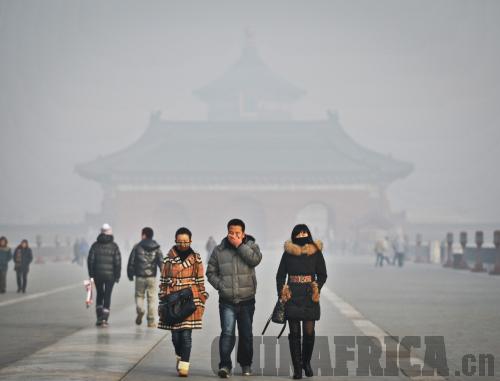|
 |
|
Haze in Beijing LI WEN |
TOp leaders vowed to build a "beautiful China" in late 2012 at the 18th National Congress of the country's ruling party. But Beijing's air quality in early 2013 has shown that China still has a long way to go before realizing that goal.
"If you have any respiratory diseases, please consult your doctor before you travel to China," suggests the Canadian Foreign Ministry on its website. This seemed to be good advice as Beijing hospitals saw a 30-percent increase in the number of patients with respiratory problems in the first month of 2013 as soaring pollution levels got national and international attention.
The air pollution problem first made headlines on January 12, when Beijing's level of PM 2.5 (harmful particulate matter smaller than 2.5 mm) reached 30 times the level deemed safe by the World Health Organization (WHO). Statistics from Beijing meteorological authorities have announced that the city enjoyed only five haze-free days in January. Official recommendations advised children and the elderly to stay home, and face masks sales skyrocketed.
Meanwhile, over 30 cities around the country suffered similar "hazardous air" conditions.
Sustainable solutions needed
Air pollution has been a headache for Beijing Municipal Government for years. In the months leading up to the 2008 Beijing Olympic Games, media all over the world focused on the city's air quality. To ensure blue skies for the big event, Beijing's environmental officials moved big steelworks out of the city, switched residence heating from coal to natural gas and raised emission standards.
In the past few years, the Chinese Government has had some success in curbing the increase of pollutants, like sulfur dioxide, by promoting energy saving and emissions reduction. It pledged in its 12th Five-Year Plan (2011-15) to cut energy consumption per unit of GDP by 16 percent, while slashing carbon emissions by 17 percent.
According to a recent report on China's environment released by the Asian Development Bank and Tsinghua University, seven of the world's top 10 most polluted cities are located in China. The report also said that fewer than five of 500 Chinese cities meet the air quality standards recommended by the WHO. Air quality has emerged to be the newest obstacle for China as the world's second largest economy fights hard to continue its miraculous economic growth.
During a meeting at the end of January, Premier Wen Jiabao called for effective measures to accelerate industrial restructuring, and push forward energy conservation and emissions reductions.
|